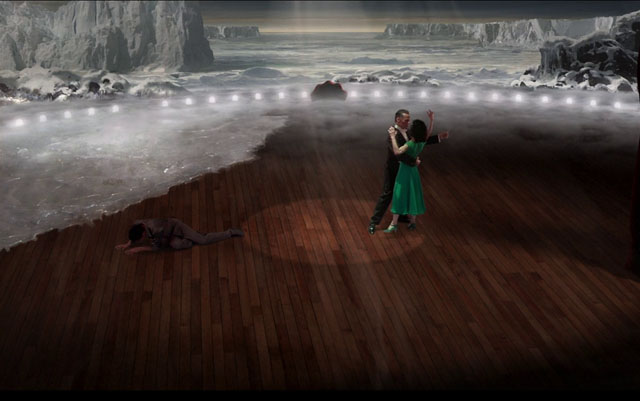However mixed the results, Youth Without Youth clearly reinvigorated Francis Ford Coppola, and led to a far more grounded movie, a vigorous family drama made by an unquestionable master. Tetro (a typically volatile Vincent Gallo) is a writer who has abandoned his family, his art, and even his real name- Angelo Tetrocini- to hide in the Argentinian town of La Boca with his too-tolerant girlfriend, Miranda, (Maribel Verdu, exuding tender sympathy). As Miranda diagnoses Tetro, he is “a genius without enough accomplishments.”

Into their lives comes young Benny (Alden “Young Han Solo” Ehrenreich). Baby-faced Benny has escaped a military life, found work on a cruise “since he knows how to wear a uniform,” and sailed South looking for the older brother who disappeared on him- and on a family whose trauma-inducing past is uncovered one reluctant revelation at a time.

Tetro isn’t doing much writing, moping around on a cast brought on by one more accident in a long series of accidents. He remains art-adjacent, working the lights at a small local theater that puts on the kind of pretentious plays that are far too easy to mock (this time it’s “Fausta,” a quasi-burlesque drama in verse). “Fausta” is a ridiculous, blacker-and-whiter version of the theatricality that once inspired Tetro, a fan of Powell and Pressburger’s color-drenched The Red Shoes and The Tales of Hoffman– a fandom he passed on to his younger brother.
Tetro introduces Benny around the black-and-white-shot La Boca, avoiding the word “hermano.” Ironically, La Boca is one of Buenos Aires most colorful neighborhood, perhaps one of the most colorful neighborhoods in the world:
Despite Coppola’s almost perverse decision to shoot La Boca in black-and-white, it remains an emotionally colorful place. This goes down to the writing on the walls, constant and unlikely. Prophetic banners warn passersby that they can’t go back; graffiti claims that love is waiting around the corner. It’s Tetro’s flash-back past that’s emotionally gray but visually colorful. In “realistic” color we see the rivalry between Tetro’s father and uncle, both genius orchestra conductors; car accidents buried under layers of avoidance; unforgivable parental betrayals; and fantastical interpretations of reality, like the balletic hallucinations in Powell and Pressburger’s movies.
(In a touch of brilliance, we get treated to a brief “remake” of Powell and Pressburger’s work by Coppola- I would have paid for the whole thing to exist.)

The sibling rivalry between the older Tetrocini generation resurfaces with the younger one when Benny finds Tetro’s unfinished “masterpiece” and gets it actually finished- and on stage- and winning the (hilariously titled) “Parricides Award” at The Patagonia Festival, thanks to a connection with “the most famous and important critic in the world”- if that’s a thing. (The critic is played by Carmen Maura, perhaps invited by Verdu. Coppola assumes her mere entrance will have the audience clamoring for the Spanish Diva- and he is probably right re: festival audiences).
Tetro threatens to turn into operatic Oedipal melodrama in its final section, but Coppola resists the tendency: the film is marked by a healing hopefulness, by a belief in the possibility of art’s ability to break negative cycles, even if some legs have to be broken in the process. (Coppola’s father, like the patriarch Tetrocini, was an orchestra conductor.)
The director has certainly made other movies about family and its imperatives, most famously The Godfather. But Tetro deals with his family burdens without concessions to the box office. No criminal plots, no gunfights: here we have balletic fantasies and choral interludes. Coppola famously, and sometimes infamously, has done nepotistically good by his relatives. Luckily for audiences, those relatives have happened to be very talented.
Shout out to composer Osvaldo Golijov, who also composed Youth Without Youth’s score, and is here more comfortable with Astor Piazzola-like accordions.


One thought on “Francis Ford Coppola’s Fruitful Old Crop 2 : “Tetro””